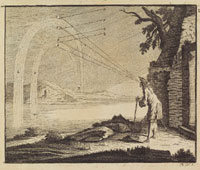Introduction
Isaac Newton (1642–1727) was the greatest and the luckiest
of mortals. The greatest because he discovered the law of universal gravitation, the
luckiest because there was only one universe. This tribute, imputed to the
eighteenth-century
French mathematician Joseph-Louis Lagrange, captures the singular position
that the
author of the Principia and the Opticks came to occupy as the acme of human
possibility. Newton’s spectacular contributions to mathematics and natural
philosophy – the discovery of the calculus, the articulation of a radical
new theory of light and colors, the unification of terrestrial and celestial
mechanics under a single law – brought the era of the Scientific Revolution
to a spectacular close. They also charted the course of science for the
next two centuries. Had he lived in antiquity, contemporaries had little doubt,
Newton
would surely have been deified.
 Plate from Shauplatz der Nature und der
Plate from Shauplatz der Nature und der
Künste (Vienna,
1774) –
General
Research Division, NYPL
But Newton’s influence transcended the domain of science. During a time
when the mathematical sciences and natural philosophy were integral to a broader
encyclopedia of knowledge, these domains set an example of so-called superior
knowledge for other disciplines to emulate: the search for rational, universal
principles became the modus vivendi for all researchers, regardless of field.
Naturally, some dissented from this summons to reorient knowledge, sparking
heated debates over the applicability of mathematics (and physics) to other
areas of
science, as well as between the sciences and the humanities over the kind of
knowledge most worth having.
With time, the historical Newton, overshadowed by the very legacy he helped
create, metamorphosed into the very personification of science. From the late
seventeenth
to the early nineteenth century, artists and architects sanctified his
genius and his contribution to science in their work.
This exhibition tells the story of the conception and diffusion of Newton’s
ideas, and the tensions and often public clashes they engendered. Notwithstanding
these burgeoning controversies, or perhaps because of them, for friends and foes
alike Newton became an icon to be emulated or rejected, revered or excoriated – but
always there to contend with. Hence, the era of Enlightenment and Revolution
may be viewed as the Newtonian Moment.
Mordechai Feingold, Curator
Professor of History, California Institute of Technology

